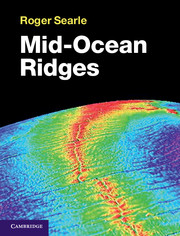Book contents
- Frontmatter
- Dedication
- Contents
- Preface
- 1 Introduction
- 2 Techniques of MOR study: a brief historical review
- 3 The oceanic lithosphere
- 4 Ridges as plate boundaries
- 5 Crustal structure and composition
- 6 Volcanism
- 7 Tectonism
- 8 Hydrothermal processes
- 9 Summary and synthesis
- Appendix A Glossary of terms
- Appendix B Directory of named features
- References
- Index
- Plate Section
3 - The oceanic lithosphere
Published online by Cambridge University Press: 05 June 2014
- Frontmatter
- Dedication
- Contents
- Preface
- 1 Introduction
- 2 Techniques of MOR study: a brief historical review
- 3 The oceanic lithosphere
- 4 Ridges as plate boundaries
- 5 Crustal structure and composition
- 6 Volcanism
- 7 Tectonism
- 8 Hydrothermal processes
- 9 Summary and synthesis
- Appendix A Glossary of terms
- Appendix B Directory of named features
- References
- Index
- Plate Section
Summary
Crust, mantle, lithosphere and asthenosphere
Traditionally, Earth scientists have divided the outer parts of the Earth into the crust and mantle. Broadly speaking these reflect a major change in chemical composition. Mantle rocks comprise a high proportion of minerals containing the elements iron and manganese, and have relatively high density (≥3300 kg m−3) and seismic P-wave velocity (≥8 km s−1); on the other hand crustal rocks, which are ultimately derived from melting (and associated fractionation) of the mantle, have lower proportions of iron and manganese, higher proportions of aluminium and silicon, and consequently lower densities and velocities. The oceanic crust is generally thinner (≤8 km) and slightly denser (~2800 kg m−3) than continental crust.
An alternative way of subdividing the Earth is based not on its composition but its mechanical properties. In this classification the outermost, relatively cool, layer is one where rocks behave in a strong, brittle or elastic manner, and is termed the lithosphere from the Greek lithos, ‘rocky’ (Dietz, 1961). Underlying this is a warmer, weak layer which, on geological timescales (~1Ma), behaves as a plastic medium, and is termed the asthenosphere (from the Greek asthenēs, ‘weak’). The viscosity of the asthenosphere is of the order of 1020 Pa s (Lowrie, 1997).
- Type
- Chapter
- Information
- Mid-Ocean Ridges , pp. 44 - 60Publisher: Cambridge University PressPrint publication year: 2013



